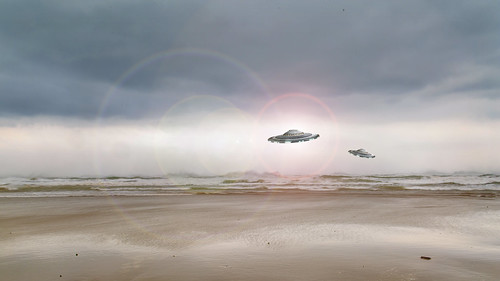‘Erratic’ Movement During Hurricane Raises Suspicions About UFOs
UFOs #UFOs

Unmanned aerial phenomena (UAP) behave erratically while flying in hurricane-force winds, according to testimony from former Navy fighter pilot Ryan Graves.
On Wednesday, the House’s Subcommittee on National Security, the Border and Foreign Affairs held a hearing about witnesses’ interactions with UAP, and Graves was one of three witnesses who testified about their experiences. The other two were ex-Navy commander David Fravor and former U.S. intelligence officer David Grusch.
Each of the witnesses said he had inexplicable encounters with UAP. The testimonies come amid a bipartisan congressional push for the Department of Defense to improve transparency on UAP encounters after Grusch said last month a top-secret military program possessed fully intact unidentified flying objects. UAP refers to any phenomenon that is seen in space or underwater that witnesses cannot explain, including UFOs.
During Wednesday’s hearing, Representative Tim Burchett, a Tennessee Republican who is co-leading the House’s UAP investigation with Florida GOP Representative Anna Paulina Luna, pressed Graves about why he was certain the UAP wasn’t a U.S. aircraft.
Hurricane Michael, whose eye is seen here in 2018, was the strongest hurricane on record to make landfall in the Florida Panhandle. On Wednesday, former Navy fighter pilot Ryan Graves gave Congress members a firsthand account of unmanned aerial phenomena behavior during hurricane-force winds. NASA/Getty
In his response, Graves described the strange behavior exhibited by the UAP during a Category 4 hurricane. Despite extremely strong winds, he said, the UAP would be at zero airspeed.
“What that means is, just like a river, if you throw a bobber in, it’s going to float downstream. These objects were staying completely stationary in Category 4 hurricane winds,” Graves said. “These same objects would then accelerate at supersonic speeds—1.1, 1.2 mock—and they would do so in very erratic and quick behaviors that I don’t have an explanation for.”
Sustained wind speeds must fall between 130 and 156 miles per hour for a hurricane to be classified as a Category 4 storm. The only hurricane stronger is a Category 5 storm, in which sustained wind speeds are 157 miles per hour or higher.
AccuWeather senior meteorologist Dave Houk told Newsweek that a Category 4 hurricane is “a pretty damaging storm” once it makes landfall.
“It’s a major hurricane,” Houk said. “That would be some of the most extreme winds we get.”
Most modern buildings would sustain severe damage, especially to the roof and exterior walls. Category 4 winds are also strong enough to uproot trees and snap power poles.
The strongest winds from a Category 4 hurricane typically do not extend more than 25 miles out from the eye of the storm, Houk said. Usually, the strongest winds take place on the northern and northeastern sides of the storm.
Aircraft usually don’t take flight during a Category 4 hurricane, but Houk said hurricane hunters will sometimes fly into the storms during their investigations. “Certainly it’s not something you want to try to do if you can avoid it,” he said.